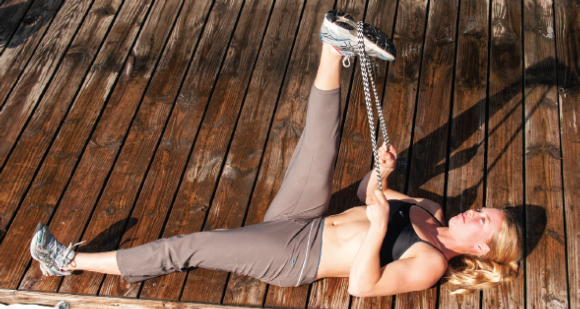Flexibility training to decrease injury risk
This is an excerpt from Sports Injuries Guidebook-2nd Edition by Robert S Gotlin.
By Jeff Young, Kinesiologist, CSCS, ACSM-EIM
Flexibility Training
Flexibility, the available range of motion (ROM) around each joint, and mobility, the amount of usable ROM in dynamic, loaded conditions, are important components of both movement and injury prevention (Page 2012, Witvrouw, Mahieu, and Danneels 2004). When restrictions exist because of lack of flexibility or mobility, movement is less efficient and the risk of injury increases. Many soft tissue injuries occur during the eccentric (lowering) phase of a movement while the muscles and tendons are under a load and on stretch (lengthening) (Verall and Dolman 2016). If a joint lacks flexibility, maximal or near-maximal lengthening of the muscles surrounding the joint will occur earlier in a movement. If this happens under a load, injury may occur. At a minimum, flexibility should be balanced around each major joint to reduce this risk (see figure 2.1).
To know objectively if a joint has restricted ROM, falls within the norms, or is hypermobile, an assessment should be performed at each major joint. It would behoove the athlete to have a joint ROM assessment performed by a qualified professional. Once this is accomplished, the athlete can be placed on a proper flexibility training program to balance flexibility around each major joint.
Designing a flexibility program adheres to a principle known as FITT. The letters stand for Frequency, Intensity, Time (duration), and Type.

© Human Kinetics
Frequency
A stretching program should be initiated even if the athlete has normal joint ROM at each joint. In that case, the minimum recommendation of twice per week will be enough to maintain joint ROM. Increased tightness, or movement restriction, calls for an increase in volume. This can be accomplished by increasing the frequency, or sets, or both—the tighter an athlete is, the more stretching is needed. Therefore, joints that fall short of normal ROM (i.e., restricted or “tight” areas) should be stretched three to seven days per week (Garber et al. 2011). Stretching must be done properly and safely. Improper stretching has been shown to increase injury.
Intensity
Intensity lies on a subjective continuum of discomfort or pain that ranges from a “gentle” stretch to “mild discomfort,” “moderate discomfort,” “very uncomfortable,” or “painful.” Interestingly, all levels of discomfort, to include stretching to a point of pain (Muanjai, Jones, and Mickevicius 2017), have been shown to increase flexibility. Logically it is not recommended to stretch to the point of pain, and current evidence recommends stretching to the point of mild to moderate discomfort (Garber et al. 2011).
Time
Stretching durations span a continuum that ranges from 10 to 15 seconds up to several minutes in length. When the goal is to increase joint ROM, the total stretch time across multiple sets is most important. Therefore, athletes have the option of holding a stretch for a longer period of time (e.g., 90 seconds) or dividing the total time into multiple sets (e.g., three sets of 30 seconds) (Frietas et al. 2014).
Type
The several types of stretching include active, passive, dynamic, static, isometric, and proprioceptive neuromuscular facilitation (PNF). Dynamic stretching is the preferred mode of stretching as part of a warm-up prior to a workout or event. Among the other types of stretching, PNF has been shown to be superior in the short term, but all types of stretching can improve joint ROM when performed properly (Garber et al. 2011, Guissard and Duchateau 2006, Page 2012).
It is important to note that muscles are viscoelastic (Ryan et al. 2009, 2012). The viscoelastic property of muscle is what allows it to be deformed (stretched); and although its elasticity will also allow it to return back to its original form, through flexibility training joint ROM can increase above baseline values. If the goal is to maintain joint ROM, athletes should stretch until they reach an “end-range feel” for the given stretch (i.e., the feeling that it would be painful if they proceeded further into the stretch), hold, and release. But if the goal is to increase joint ROM, they should stretch until they reach their end range, hold, mentally relax into the stretch, and then increase the stretch to a new end range. This is known as muscle creep, or “creeping further into the stretch,” and the viscoelastic property of muscle, along with relaxation of the nervous system during the stretch, allows for this. The point: If athletes want to increase joint ROM but stretch only to their first end range (never taking advantage of muscle creep and neural relaxation that allows for an increase in ROM), the body is not signaled to progress, and the stretching will be fruitless. It is imperative to remember to find a second, and if possible, a third end range within each set of a stretch when the goal is to improve flexibility.
Self-myofascial release (SMR) is another method of increasing joint ROM, and while SMR will not directly decrease the chance of injury, because it assists in improving ROM and may increase performance as well, it should be included as part of a flexibility training program and warm-up (Beardsley and Skarabot 2015, Schroeder and Best 2015). While it is beyond the scope of this chapter to provide significant detail, SMR follows the FITT protocol and should be used concurrently with stretching, typically just prior to performing various stretches. Please see Cheatham and colleagues (2015) for more information.
More Excerpts From Sports Injuries Guidebook-2nd EditionSHOP

Get the latest insights with regular newsletters, plus periodic product information and special insider offers.
JOIN NOW


